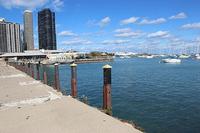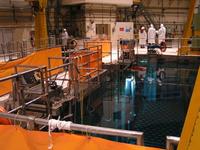-
Florida's First Coast region trying to cope with rising seas
City planners in Florida’s First Coast region are taking steps to avoid massive destruction to property and human life as sea level rise is expected to cause mass flooding and super storms during the next few decades. Some groups are lobbying for coastal property-insurance reforms, while others are researching ways to help historic properties manage flooding.
-
-
Exploring ways to deal with Great Lakes water-level changes

Extreme water-level fluctuations in the Great Lakes, including historic lows on lakes Michigan and Huron in 2013 and substantial upward trends in 2014, are creating serious challenges for many shoreline property owners, tourism-related businesses, municipal planners, and others. To help these community decision makers determine the best strategies for dealing with these water-level changes, a two-tiered, two-year research initiative has been launched with the goal of developing information, tools, and partnerships to help decision makers address challenges and opportunities posed by water-level variability.
-
-
Water’s role in the rise and fall of the Roman Empire
The Roman Empire, stretching over three continents and persisting for many centuries, was home to an estimated seventy million people. In such a vast area ensuring a stable food supply was no easy task, particularly given the variable and arid climate of the Mediterranean region. Smart agricultural practices and an extensive grain-trade network enabled the Romans to thrive in the water-limited environment of the Mediterranean, a new study shows. The stable food supply brought about by these measures, however, promoted population growth and urbanization, pushing the Empire closer to the limits of its food resources.
-
-
Turning excess space into apartments as an incentive for earthquake-retrofitting of buildings
San Francisco is dealing with a housing shortage at the same time that city officials are trying to get landlords to retrofit buildings which are at risk of crumpling during a severe earthquake. In 2013, Mayor Ed Lee approved a bill that mandates retrofits for soft-story multi-unit residential buildings over the next four to seven years. Roughly 4,800 buildings of two or more stories, containing five or more apartment units, which were approved for construction before January 1978, have to be retrofitted, according to the mandate.A member of San Francisco’s Board of Supervisors, recently proposed that building owners of at-risk apartment buildings be allowed to finance earthquake retrofits by converting garages, basements, and other excess space into apartments –a plan which would also increase the city’s housing stock.
-
-
Storing hydrogen underground could boost transportation, energy security
Large-scale storage of low-pressure, gaseous hydrogen in salt caverns and other underground sites for transportation fuel and grid-scale energy applications offers several advantages over above-ground storage, says a recent Sandia National Laboratories study sponsored by the Department of Energy’s Fuel Cell Technologies Office. Geologic storage of hydrogen gas could make it possible to produce and distribute large quantities of hydrogen fuel for the growing fuel cell electric vehicle market.
-
-
McAfee Labs report previews 2015 cyber threats, exploits, evasions
McAfee Labs November 2014 Threats Report offers an analysis of threat activity in the third quarter of 2014, and the organization’s annual 2015 Threats Predictions for the coming year. The report details a third quarter filled with threat development milestones and cyber events exploiting long-established Internet trust standards. McAfee Labs forecasts a 2015 threat landscape shaped by more attacks exploiting these standards, new attack surfaces in mobile and Internet of Things (IoT), and increasingly sophisticated cyber espionage capabilities, including techniques capable of evading sandboxing detection technologies.
-
-
Re-thinking Southern California earthquake scenarios

New three-dimensional (3D) numerical modeling that captures far more geometric complexity of an active fault segment in southern California than any other, suggests that the overall earthquake hazard for towns on the west side of the Coachella Valley such as Palm Springs and Palm Desert may be slightly lower than previously believed.
-
-
Coordinated cyberattacks by Iran-based hackers on global critical infrastructure
Irvine, California-based cybersecurity firm Cylance last week released a report detailing coordinated attacks by hackers with ties to Iran on more than fifty targets in sixteen countries around the globe. Victim organizations were found in a variety of critical industries, with most attacks on airlines and airports, energy, oil and gas, telecommunications companies, government agencies and universities.
-
-
Growing cybersecurity threats offer opportunities for cybersecurity businesses
A 2013 report from the U.S. Computer Emergency Readiness Team(US-CERT) noted that the number of cyberattacks reported by federal agencies had skyrocketed 782 percent since 2006, to nearly 49,000, in 2012. Today, the figure is much higher. The increasing threat of cyberattacks from domestic and foreign actors has opened up opportunities for cybersecurity professionals, many of whom held positions with the U.S. military or intelligence agencies. For the private sector, cybersecurity spending is expected to reach $71.1 billion this year, and expected to grow about 9 percent annually through 2016.
-
-
Insurance industry needs support to address effects of climate change on the built environment
A new report finds that the increasing frequency of extreme weather brought on by climate change adversely affects real estate values and increases the probability of property damage occurring in urban areas. In the last ten years alone, direct losses in real estate and infrastructure as a result of natural disasters has tripled, reaching $150 billion per year. The report highlights the steps the insurance industry has taken to adopt risk standards for climate change across the industry, from catastrophe models and scenario analysis to insurance products that incentivize risk-reducing building practices.
-
-
Using earthquake research to refine fracking methods
Researchers at Oklahoma State University (OSU) are using historical earthquake data to make oil and natural gas drilling more efficient. Members of the university research team found that hydraulic fracturing, or fracking, a process in which water and sand are blasted at high pressure into rock to remove oil, can cause an effect similar to earthquakes. Data gleaned from historical earthquake experiences have told scientists much about what happens to the rock during such events – and the knowledge may allow oil companies to understand how to extract gas without also removing groundwater.
-
-
DOJ’s new cyber unit to provide legal guidance on electronic surveillance
The Justice Department is creating a cybersecurity unit within its Computer Crime & Intellectual Property Section (CCIPS) to provide legal guidance on electronic surveillance investigations.The unit will also work with Congress on cybersecurity legislation and focus on cybercrime prevention.
-
-
Improving nuclear power plant safety by looking at nature
Within the nuclear industry, hazardous salt solutions can arise within industrial containment vessels. The salt solution precipitates out, forming structures with strange morphologies that bear a resemblance to stalagmites. If left unchecked, they could build up and cause a problem in the nuclear containment chamber. Currently, these containment chambers are checked regularly to prevent this from happening. Taking inspiration from nature, researchers have created a versatile model to predict how stalagmite-like structures form in nuclear processing plants — as well as how lime scale builds up in kettles.
-
-
Risks of terrorists attacking, or using materials from, a nuclear power plant are low: Experts

Energy analysts who support new nuclear power plants construction insist that the probability of a terrorist nuclear attack by land, sea, or air is extremely low. They reject arguments by nuclear power opponents that terrorist groups may one day attack a nuclear plant, or build an improvised nuclear bomb using materials stolen from a nuclear power plant – and that governments should, therefore, end construction of new nuclear power plants. Climate scientists supporting reduction in CO2 emissions wrote that “There is no credible path to climate stabilization that does not include a substantial role for nuclear power.”
-
-
Washington State supports new Hanford project, but worries about cost
The state of Washington is supporting a new facility which would lessen the load on the Hanford vitrification (vit) plant to process nuclear waste, but has expressed concerns about how the U.S. Department of Energy (DOE) will pay for the project. Only rough estimates of the cost of the project – called LAWPS, or the Low-Activity Waste Pretreatment System — have been made, but these estimates run between $243 million and $375 million, though that number does not include infrastructure costs such as the addition of roadways and utility services.
-
More headlines
The long view
Falling Space Debris: How High Is the Risk I'll Get Hit?
An International Space Station battery fell back to Earth and, luckily, splashed down harmlessly in the Atlantic. Should we have worried? Space debris reenters our atmosphere every week.
Using Drone Swarms to Fight Forest Fires
Forest fires are becoming increasingly catastrophic across the world, accelerated by climate change. Researchers are using multiple swarms of drones to tackle natural disasters like forest fires.
Strengthening the Grid’s ‘Backbone’ with Hydropower
Argonne-led studies investigate how hydropower could help add more clean energy to the grid, how it generates value as grids add more renewable energy, and how liner technology can improve hydropower efficiency.
LNG Exports Have Had No Impact on Domestic Energy Costs: Analysis
U.S. liquified natural gas (LNG) exports have not had any sustained and significant direct impact on U.S. natural gas prices and have, in fact, spurred production and productivity gains, which contribute to downward pressure on domestic prices.
